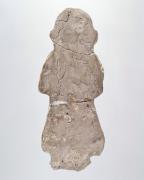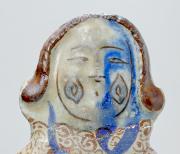ラスター彩人物像 らすたーさいじんぶつぞう
Man-shaped Luster-painted Tile
|
陶器
Glazed pottery
イラン
Iran
14世紀頃
ca. 14th century CE
高 16.0 cm, 幅 9.0 cm
H. 16.0 cm, W. 9.0 cm
ラスター彩陶器の「ラスター」とは、金属的な光沢を意味します。両手で杖か刀をもったこの男性像は、壁面などを飾るタイルとして用いられたものでしょうか。表面には文様が描かれ釉薬が掛けられていますが、裏面にはありません。
全体が金属質のきらめきをもった顔料で彩られていますが、金属を含む顔料を、酸素の極めて少ない環境で焼成することでこのような輝きを生み出します。ラスター彩のタイルや陶器は、イランでは12世紀から14世紀頃に盛んに作られていました。
この製品には藍色がアクセントのように使われています。青はイスラム世界で時代を超えて愛された色で、しばしばラスター彩とも組み合わされています。
Luster-painted tiles of various shapes and sizes were important architectural elements in Islamic art. This tile is in the form of a man standing with a sword-like object.
The surface is decorated with brown and cobalt designs on white, and it retains an overall lustrous quality. The metallic glints are produced when the glazed and fired pottery is covered with a thin coat of metallic salts and refired at a low temperature.
Luster-painted tiles and pottery were produced in the 12th to 14th centuries in Iran. Painting in luster added a new dimension to the ceramic art, because luster vessels had the preciousness of the metal it imitated.
|





